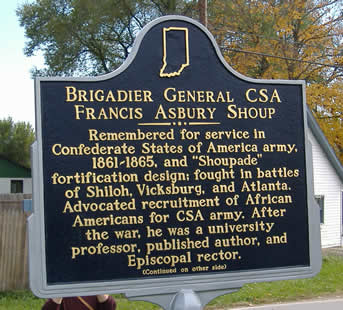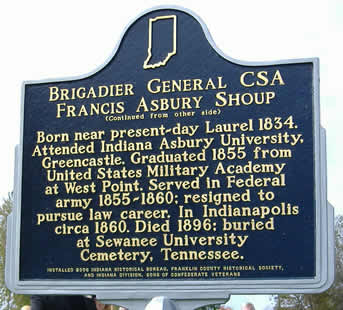

Location: Conwell Cemetery, State Rd. 121, Laurel (Franklin County, Indiana)
Installed: 2006 Indiana Historical Bureau, Franklin County Historical Society, and Indiana Division, Sons of Confederate Veterans
ID#: 24.2006.1
 This marker contains inaccuracies. Read the report here.
This marker contains inaccuracies. Read the report here.
Text
Side one:
Remembered for service in Confederate States of America army, 1861-1865, and "Shoupade" fortification design; fought in battles of Shiloh, Vicksburg, and Atlanta. Advocated recruitment of African Americans for CSA army. After the war, he was a university professor, published author, and Episcopal rector.
Side two:
Born near present-day Laurel 1834. Attended Indiana Asbury University, Greencastle. Graduated 1855 from United States Military Academy at West Point. Served in Federal army 1855-1860; resigned to pursue law career. In Indianapolis circa 1860. Died 1896; buried at Sewanee University Cemetery, Tennessee.
Keywords
Military, Education, African American
Annotated Text
Remembered for service in Confederate States of America army, 1861-1865, (2) and "Shoupade" fortification design;(3) fought in battles of Shiloh, Vicksburg, and Atlanta.(4) Advocated recruitment of African Americans for CSA army.(5) After the war, he was a university professor, published author, and Episcopal rector.(6)
Born near present-day Laurel 1834.(7) Attended Indiana Asbury University, Greencastle.(8) Graduated 1855 from United States Military Academy at West Point.(9) Served in Federal army 1855-1860; resigned to pursue law career.(10) In Indianapolis circa 1860. (11) Died 1896; buried at Sewanee University Cemetery, Tennessee.(12)
(1) Raab states that Shoup made Brigadier-General, September 13, 1862. James W. Raab, A Dual Biography: General Lloyd Tilghman & General Francis Shoup (Murfreesboro, Tenn., 2001), 149, 169. (B00039) The two following sources give the date as September 12, 1862: General Clement A. Evans, ed., Confederate Military History Extended Edition (North Carolina, 1987, orig. 1899), 16: 209; (B00565) Ezra J. Warner, Generals in Gray, Lives of the Confederate Commanders (Baton Rouge, 1959), 275-76. (B00529)
(2) Raab, Dual Biography, 153-54, 157, 210. (B00039) Evans, Confederate Military History, 208-10. (B00565) Warner, 275-76. (B00529)
(3) Raab, Dual Biography, 191, 193-95, illustration on 196. (B00039)
Shoup states in a published paper, that General G. W. Smith named Shoup's fortifications along the Chattahoochee River "Shoupades." "Dalton Campaign ”Works at Chattahoochee River” Interesting History, " Confederate Veteran, 3:9 (September 1895), 263. (B00530)
Sherman mentioned strong fortification along the Chattahoochee River. William T. Sherman, Memoirs of General W. T. Sherman (New York, 1990), 535-36. (B00531)
William Scaife provides a brief "Study" of the battle for Atlanta, which states the importance of the fortifications in Johnston's defense of Atlanta. William R. Scaife, "The Campaign for Atlanta, " www.state.ga.us/civilwar/atlanta.html (accessed January 26, 2005). (B00534)
(4) Raab, Dual Biography, 160-64, 175-81, 185-202. (B00039) Confederate Veteran, 2:5 (May 1894), 137-40. (B00537). Confederate Veteran 2:6 (June 1894), 172-74. (B00535). Confederate Veteran 3:9 (September 1895), 262-65. (B00530) Shoup's journal after the fall of Atlanta is reprinted in War of the Rebellion Official Records Series I (Washington, 1901), 39:803-08. (B00543)
(5) Raab, Dual Biography, 202-209, (B00039) prints part of Shoup article on black recruitment originally published in Richmond Whig, February 20, 1865; New York Times, February 26, 1865, (B00683) under a general heading "From the South, " quotes Shoup from the Richmond Whig article, and others, in a section on recruitment of blacks/Negro Soldiers for the Confederate army. The Confederate "Congress approved the incorporation of blacks into the army on March 13, [1865]." Raab, Dual Biography, 208. (B00039) Shoup requested to command black troops March 1865. Raab, Dual Biography, 209. (B00039)
(6) After the war, Shoup taught at University of Mississippi, 1865-1875 ”physics, astronomy and civil engineering until 1867; then metaphysics, aesthetics, logic, and political philosophy. Shoup took orders in the Episcopal Church, 1868. In 1869, he became Professor of Mathematics at the University of the South, Sewanee, Tennessee. He left in 1875, serving as rector at churches in various locations. Shoup returned to the University of the South in 1883 as professor of mathematics, physics, and engineering. Historical Catalogue of the University of Mississippi (Nashville, 1910), 20-21; (B00541) Dumas Malone, ed., Dictionary of American Biography (New York, 1935), 17:130-31; (B00528) Who Was Who in America, Historical Volume, 1607-1896 (Chicago, 1963), 482; (B00532)
Rev. Francis A. Shoup, D.D. was listed as Rector of the Columbia Institute, Columbia, Tennessee. Confederate Veteran 2:6 (June 1894), back cover. (B00535)
Books that Shoup authored include Infantry Tactics (1862); Artillery Division Drill (1864); Elements of Algebra (1874); Mechanism and Personality (1891). Magazine articles he wrote included "How We Went to Shiloh, " Confederate Veteran, May 1894; "Vicksburg, " Confederate Veteran, June 1894; "Dalton Campaign", " Confederate Veteran, September 1895; "Uncle Tom's Cabin 40 Years Later, " Sewanee Review. He also authored a pamphlet on proposed Negro troops in the Confederate army: Policy of Employing Negro Troops (1865).
Who was Who in America, 482;(B00532) Dictionary of American Biography, 17:131;(B00528) Encyclopedia of the American Civil War, 1781.(B00684).
(7)Most sources give his birth date as 1834. Raab, Dual Biography, 155; (B00039) Malone, ed., 17:130; (B00528) Who Was Who, 482; (B00532) Richard Owen, Generals at Rest: The Gravesites of the 425 Official Confederate Generals (Shippensburg, Penn., 2001), 231. (B00529)
However, his grave marker pictured in Owen, p. 231, indicates 1835; this date might have come from his wife, who is indicated as the source for his biographical sketch (in which there are several date errors) in the Historical Catalogue of the University of Mississippi, 20-21. (B00541)
Laurel did not exist in 1834. Nearby, the Conwells Mills post office was established May 31, 1832. This post office was changed to Laurel on July 26, 1837. J. David Baker, The Postal History of Indiana, 2 vols. (Louisville, Ky., 1976), 2: 919, 966.
(8)Shoup's name is included in Catalogue of the Officers and Students of the Indiana Asbury University for 1848, 1849, 1850 (Greencastle, IN, 1848, 1850, 1851), 13, 11, 10. (B00539)
One author lists alumni who served as generals in the military. Shoup is listed as "ex-1851." George B. Manhart, DePauw Through the Years, (Greencastle, 1962), 1:Appendix G, 563. (B00533)
(9) Confederate Military History, 16: 208; (B00565) Gerard A. Patterson, Rebels from West Point (New York, 1987), 162; (B00542) "Examination at West Point, " New York Times, June 2, 1855. (B00545)
(10) Confederate Military History, 16: 208; (B00565) Malone, ed., 17: 130; (B00528) Who Was Who, 482; (B00532) Raab, Dual Biography, 155-56. (B00039)
(11)US Census 1860, Schedule 1, Third Ward, Marion County, Indiana, enumerated June 19, 1860, p. 103 (B00540) Raised Independent Zouaves company 1860 in Indianapolis after John Brown's raid on Harpers Ferry. Malone, ed., American Biography, 17:130. (B00528) Visited Charleston, S.C. 1860, then Florida 1861 to enlist in Confederate Army. Raab, Dual Biography, 155-56. (B00039) Indianapolis Daily Journal, January 30, 1861, (B00537) indicated that Shoup had resigned his command in the Independent Zouaves, a voluntary military company, and gone to Florida. Ibid., October 19, 1861 (B00536) lists Shoup as one of "four former residents" who "are now in the ranks of the army of traitors under Jeff. Davis." Raab, Dual Biography, 155-56, (B00039) indicating that his source is Shoup's personal letters, mixes summary and quotations, to provide some of Shoup's rationale for joining the Confederacy: Shoup was convinced that "the election of Lincoln would lead to a war of the sections' " and he "had a great horror of abolitionism" (155). Given his military training, Shoup knew he would have to serve in the military on one side or the other: "My whole nature rebelled against the Republican party and it seemed to me that the one thing to do was to change my residence' " (155-56). Shoup moved to the south before South Carolina seceded, even though he believed that he had "prospects of high command" in the north (156). Shoup attended the Secession Convention of December 1860 in Charleston, S.C. (156).
For descriptions of the political climate in Indiana just before the Civil War see: Lorna Lutes Sylvester, "Oliver P. Morton and Southern Politics, " Indiana University PhD History, chapters 1 and 2 (1968) (B00584). For the national picture see: Steven A. Channing, Crisis of Fear (New York, 1970) (B00585), pp. 286-93. For an explanation of the huge impact of John Brown's raid see: Clement Eaton, A History of the Southern Confederacy (New York, 1954), 1-7. (B00586)
(12) Raab, Dual Biography, 212-13; (B00039) Who Was Who, 482; (B00532) Malone, ed., American Biography, 17: 130-31; (B00528) Owen, Generals at Rest, 231. (B00529) His grave marker reads: "Rev. Francis Asbury Shoup, D.D. - Priest - Mar. 22, 1835 “Sept. 4, 1896." See note (7) preceding regarding birth date.
